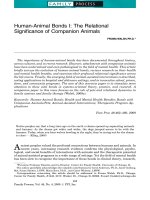Tài liệu Issues Involved When Updating the Primary Key of a Parent Row pptx
Bạn đang xem bản rút gọn của tài liệu. Xem và tải ngay bản đầy đủ của tài liệu tại đây (33.12 KB, 6 trang )
Issues Involved When Updating the Primary Key of a Parent Row
In this section, you'll learn about the issues involved when attempting to update the
primary key in a parent DataTable, and then pushing the update to the underlying
database table. The issues occur when the child database table already contains rows that
use the primary key you want to change in the parent table.
The examples in this section will use the Customers and Orders table, which are related
through the foreign key on the CustomerID column of the Orders table to the CustomerID
column of the Customers table.
As you'll learn, you're much better off not allowing changes to the primary key column of
a table. If you allow changes to the primary key column, then as you'll see shortly, you
can run into problems when pushing the change to the database. Instead, you should set
the ReadOnly property to true for the primary key DataColumn in your parent DataTable,
and also set ReadOnly to true for the foreign key DataColumn in your child DataTable.
That prevents changes to the values in these DataColumn objects.
If you really need to change the primary key and foreign key values, you should delete
and then recreate the rows in the database with the new primary key and foreign key
values.
You can control how updates and deletes are performed using the properties of the
foreign key in the SQL Server database and also the UpdateRule and DeleteRule
properties of a ForeignKeyConstraint object. You'll explore both of these items in the
following sections.
Controlling Updates and Deletes Using SQL Server
You can control how updates and deletes are performed using SQL Server by setting the
properties of the foreign key. You set these properties using the Relationships tab of a
database table's Properties dialog box. You open this dialog box in Enterprise Manager
for the Orders table by performing the following steps:
1. Right-click the Orders table in the Tables node of Enterprise Manager.
2. Select Design Table from the pop-up list.
3. Press the Manage Relationships button in the toolbar of the Design Table dialog
box.
4. Select the foreign key you want to examine in the Select relationship drop-down
list.
Figure 12.1 shows the Relationships tab for the foreign key named
FK_Orders_Customers that contains the details of the foreign key between the Orders
and Customers tables. As you can see, these two tables are related through a foreign key
on the CustomerID column.
Figure 12.1: The Relationships tab for FK_Orders_Customers
The Cascade Update Related Fields check box indicates whether a change to a value in
the primary key column of the primary key table (the parent table) is also made to the
foreign key column of the corresponding rows of the foreign key table (the child table).
For example, assume this box is checked and you changed the CustomerID in the row of
the Customers table from ALFKI to ANATR; this would also cause the CustomerID
column to change from ALFKI to ANATR in the rows of the Orders table.
Similarly, the Cascade Delete Related Records check box indicates whether deleting a
row in the primary key table also deletes any related rows from the foreign key table. For
example, assume this box is checked and you deleted the row with the CustomerID of
ANTON from the Customers table; this would cause the rows with the CustomerID of
ANTON to also be deleted from the Orders table.
Note Typically, you should leave both check boxes in their default unchecked state. If
you check them, the database will make changes to the rows in the child table
behind the scenes and as you'll see shortly, you'll run into problems when pushing
changes from your DataSet to the database.
Controlling Updates and Deletes Using the UpdateRule and DeleteRule Properties of
a ForeignKeyConstraint Object
You can also control updates and deletes using the UpdateRule and DeleteRule properties
of a ForeignKeyConstraint object. These properties are of the System.Data.Rule
enumeration type; members of this type are shown in Table 12.4
.
Table 12.4: Rule ENUMERATION MEMBERS
CONSTANT DESCRIPTION
Cascade Indicates that the delete or update to the DataRow objects in the parent
DataTable are also made in the child DataTable. This is the default.
None Indicates that no action takes place.
SetDefault Indicates that the DataColumn values in the child DataTable are to be set
to the value in the DefaultValue property of the DataColumn.
SetNull Indicates that the DataColumn values in the child DataTable are to be set
to DBNull.
By default, UpdateRule is set to Cascade; therefore, when you change the DataColumn in
the parent DataTable on which the ForeignKeyConstraint was created, then the same
change is also made in any corresponding DataRow objects in the child DataTable. You
should set UpdateRule to None in your program; otherwise, as you'll learn in the next
section, you'll run into problems when pushing changes from your DataSet to the
database.
By default, DeleteRule is set to Cascade; therefore, when you delete a DataRow in the
parent DataTable, any corresponding DataRow objects in the child DataTable are also
deleted. This is fine, as long as you remember to push the deletes to the child table before
you push the deletes to the parent table.
Updating the Primary Key of a Parent Table and Pushing the Change to the
Database
In this section you'll learn what happens if you attempt to update the primary key in a
parent table when there are corresponding rows in the child table. Assume the following:
•
There is a row in the Customers table with a CustomerID of J6COM. A copy of
this row is stored in a DataTable named customersDT.
•
There is a row in the Orders table that also has a CustomerID of J6COM. A copy
of this row is stored in a DataTable named ordersDT.
•
The customersDT and ordersDT DataTable objects are related to each other using
the following DataRelation:
•
DataRelation customersOrdersDataRel =
•
new DataRelation(
•
"CustomersOrders",
•
customersDT.Columns["CustomerID"],
•
ordersDT.Columns["CustomerID"]
•
);
•
myDataSet.Relations.Add(
•
customersOrdersDataRel
•
);
Now, the two settings for the Cascade Update Related Fields check box for
FK_Orders_Customers are
•
Unchecked, meaning that changes to the CustomerID primary key value in the
Customers table are not cascaded to the Orders table. This is the default.
•
Checked, meaning that changes to the CustomerID primary key value in the
Customers table are cascaded to the Orders table.
In addition, the settings of interest for the UpdateRule property of the
ForeignKeyConstraint object added when the earlier DataRelation was created are
•
Cascade, meaning that changes to the CustomerID DataColumn of customersDT
are cascaded to ordersDT. This is the default.
•
None, meaning that changes to the CustomerID DataColumn of customersDT are
not cascaded to ordersDT.
Let's examine the three most important cases that vary the checking of the Cascade
Update Related Fields box and setting of the UpdateRule property to Cascade and then
None.
Note You can use the ModifyingRelatedData2.cs program as the basis for trying out the
three cases described in this section.
First Case
Assume the following:
•
Cascade Update Related Fields box is checked.
•
UpdateRule is set to Cascade.
If you change to the CustomerID DataColumn from J6COM to J7COM and push the
change to the database, then the change is made successfully in the customersDT and
ordersDT DataTable objects and also in the Customers and Orders database tables.
This works as long as you use only the OrderID column in the WHERE clause of the
Command object in the UpdateCommand property of your DataAdapter. For example:
ordersUpdateCommand.CommandText =
"UPDATE Orders " +
"SET " +
" CustomerID = @NewCustomerID " +
"WHERE OrderID = @OldOrderID";
This UPDATE uses "last one wins" concurrency since only the OrderID primary key
column is used in the WHERE clause (the old CustomerID column is left out of the
WHERE clause). As mentioned in the previous chapter
, "last one wins" concurrency is
bad because one user might overwrite a change made by another user.
If instead you also include the old CustomerID column value in the WHERE clause of
the UPDATE, as shown in the following example,
ordersUpdateCommand.CommandText =
"UPDATE Orders " +
"SET " +
" CustomerID = @NewCustomerID " +
"WHERE OrderID = @OldOrderID " +
"AND CustomerID = @OldCustomerID";
then pushing the change to the database would fail because the original row in the orders
table wouldn't be found. The original row wouldn't be found since the CustomerID has
already been changed from J6COM to J7COM in the Orders table automatically by the
database because Cascade Update Related Fields is checked for the foreign key in the
Orders table, but in ordersDT the old CustomerID is set to J6COM. Therefore, the
addition of OrderID = @OldOrderID in the WHERE clause prevents the row from being
found. Instead, the UPDATE causes a DBConcurrencyException to be thrown.
Second Case
Assume the following:
•
Cascade Update Related Fields is unchecked.
•
UpdateRule is set to Cascade.
•
The CommandText property of the Command object in the UpdateCommand
property of the DataAdapter is set as follows:
•
ordersUpdateCommand.CommandText =
•
"UPDATE Orders " +
•
"SET " +
•
" CustomerID = @NewCustomerID " +
•
"WHERE OrderID = @OldOrderID";









